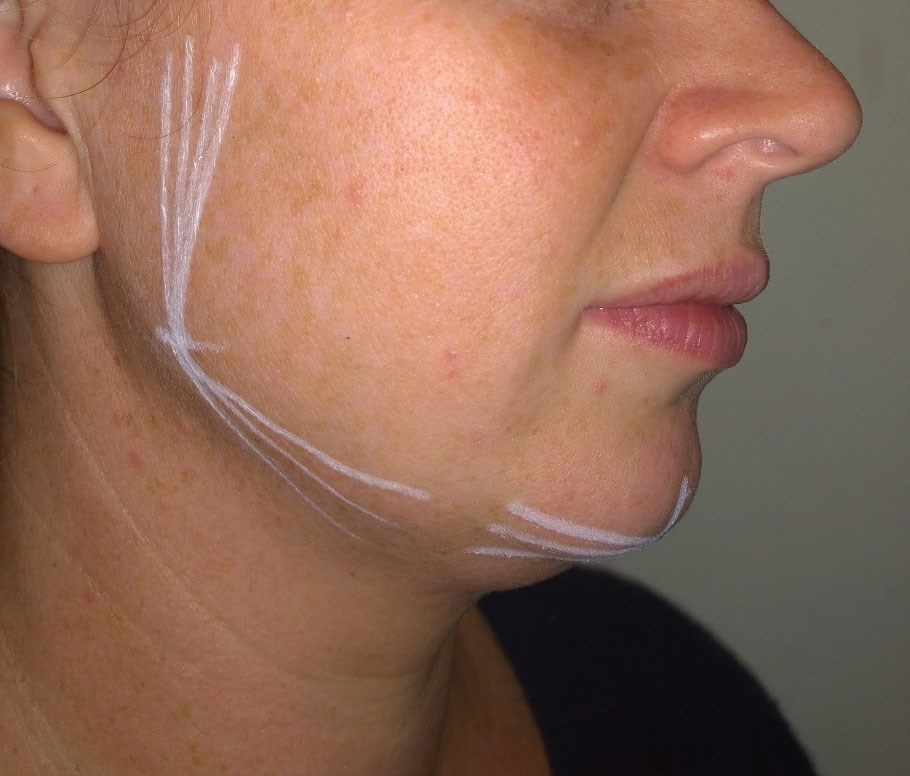It is important to invest time in analysing the lower aspect of the face whilst in discussion with the patient to establish a mutual agreement as to the level of desired correction along with the choice of product. I find it useful to map the area topographically prior to commencing the procedure. It is important to locate the facial artery as it crosses the inferior border of the mandible, situated between the anterior border of masseter, and the superior border of the depressor anguli oris.
When palpated it may feel like a piece of string rolling against the mandible, though this may be felt more easily on some individuals than others. The skin is cleaned thoroughly using sterile gauze and chlorhexidine and the procedure performed aseptically. I prefer to use a 25g cannula in several lengths for this region as I find this is a safer gauge given the anatomical structures in this region. I use a 25g needle to make all points of entry when using a size 25g cannula.
My product choice for contouring the jawline is calcium hydroxylapatite due to the unique viscosity and G Prime properties, which allow it to withstand high tension, yet its elasticity and volumising characteristics denote that less product is required to achieve the desired level of correction when compared to products comprised of different formulations. This demonstrates that it is a superior choice for rejuvenating dynamic areas, particularly the mobile regions of the lower aspect of the face.
Non-Surgical Figure

Figure 1.
An approach that I favour to strengthen and contour the lateral aspect of the jawline, is to commence point of entry at the gonion, anteriorly, using a 25gx50mm cannula to make a series of fine linear threads of product along the periosteum to provide definition. Additionally, if required I may combine a subtle lifting approach with this technique, using the same size cannula subdermally to lay fine threads superiorly, towards the zygoma, which can produce a subtle and gradual tightening and lifting of the superficial tissues. This approach may benefit a patient who has slight skin laxity at the jawline or pre-jowl region, especially if combined with linear threads placed along the periosteum along the height of the ramus, superiorly. Placing calcium hydroxylapatite along the periosteum is also advantageous in correcting the bone resorbtion associated with the senescent changes, which occur at the mandible.
Product may also be placed subdermally using the linear thread technique described previously at the same point of entry at the gonion. I prefer a 25gx25mm cannula as I find this length allows me to extend to the superior border of the superficial jowl fat and avoid placing product in this compartment. I prefer to place product subdermally for a male patient as it emulates a masculine and defined lateral aspect to the jaw, which is generally not suited to a female jawline. Male jawlines can also benefit from a periosteal bolus with a sharp 27g needle deposited on the gonion to give square definition.
To improve the contour at the pre-jowl region, I usually make an entry point medially at the mentum, again using a 25gx25mm cannula to proceed posteriorly to lay fine threads of product, which can extend just under the pre-jowl region, caudally, in the subdermal plane. Periosteal placement using linear threads has an added benefit if the loss of contour is pronounced, especially with an additional layer of product placed subdermally to produce an effective and long lasting result. To give support to the mentum and the mandibular length, I place a bolus at the most medial protuberance to give support to the anterior angle of the mandible, which is particularly effective if the mentum lacks definition.
Declaration of competing interests: None declared.
COMMENTS ARE WELCOME





